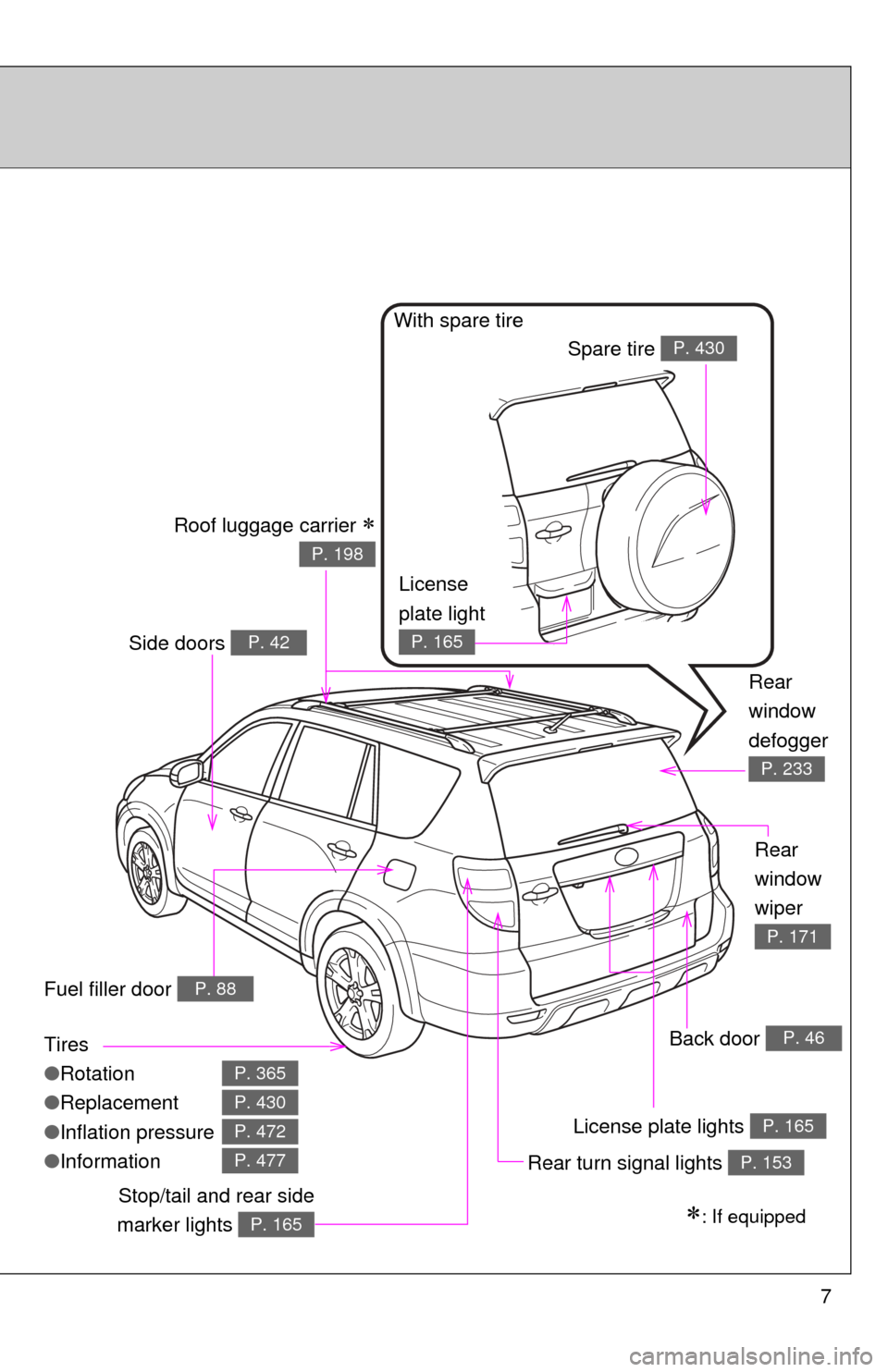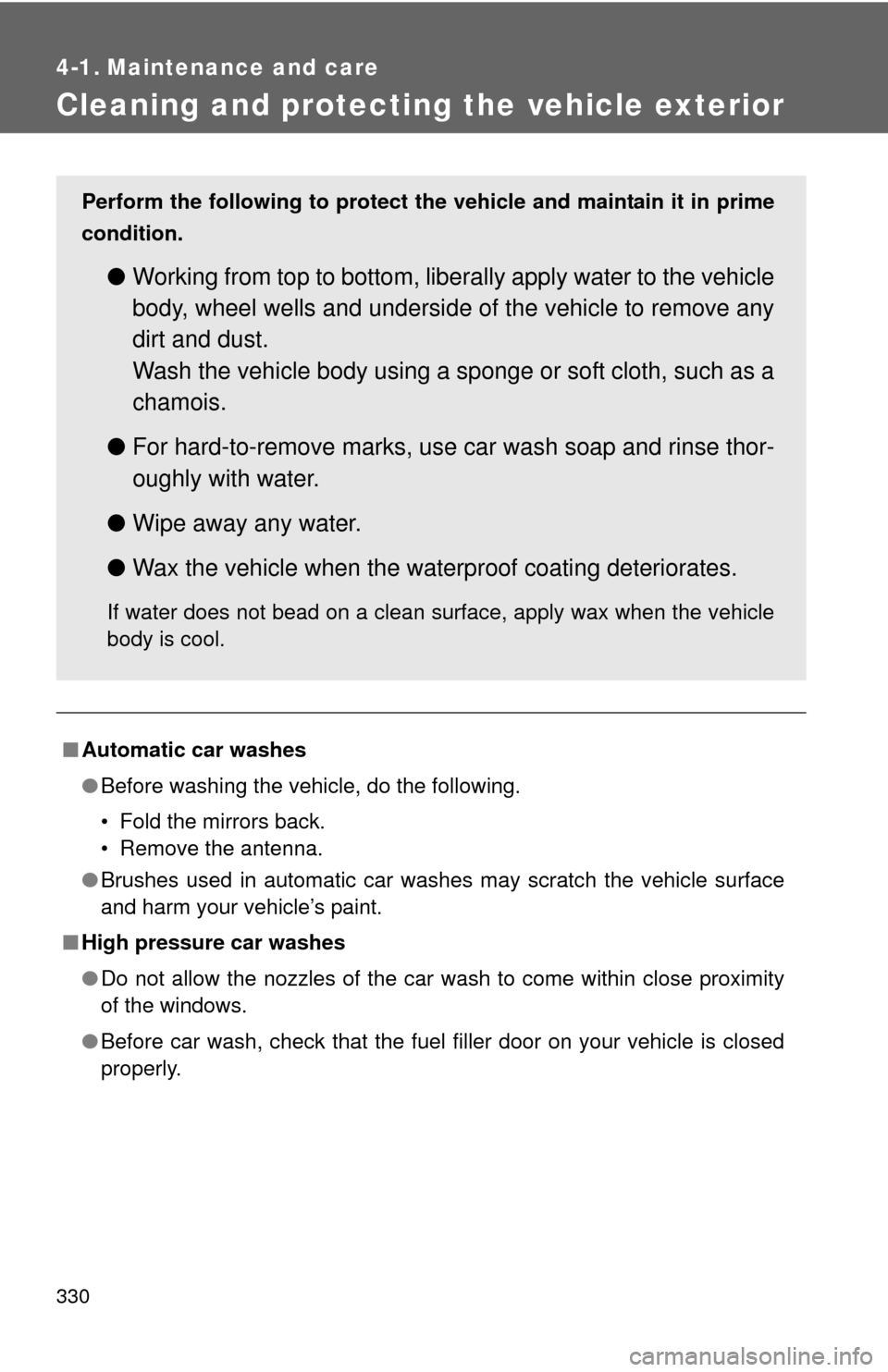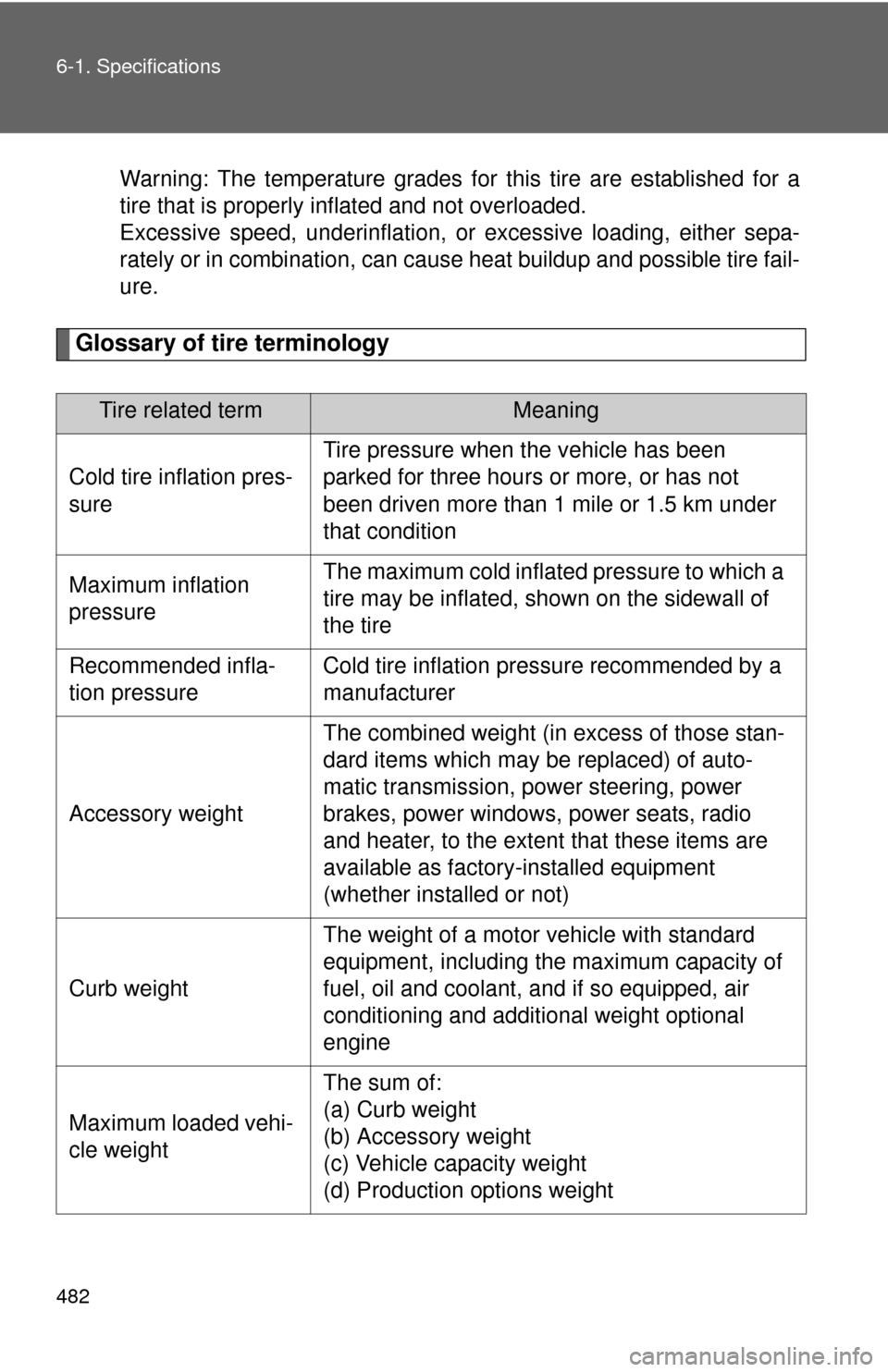2010 TOYOTA RAV4 fuel pressure
[x] Cancel search: fuel pressurePage 7 of 513

7
Tires
●Rotation
● Replacement
● Inflation pressure
● Information
P. 365
P. 430
P. 472
P. 477
Back door P. 46
Rear turn signal lights P. 153
: If equippedStop/tail and rear side
marker lights
P. 165
Rear
window
wiper
P. 171
License plate lights P. 165
Side doors P. 42
Rear
window
defogger
P. 233
License
plate light
P. 165
With spare tire Spare tire
P. 430
Fuel filler door P. 88
Roof luggage carrier
P. 198
Page 331 of 513

330
4-1. Maintenance and care
Cleaning and protecting the vehicle exterior
■Automatic car washes
●Before washing the vehicle, do the following.
• Fold the mirrors back.
• Remove the antenna.
● Brushes used in automatic car washes may scratch the vehicle surface
and harm your vehicle’s paint.
■ High pressure car washes
●Do not allow the nozzles of the car wash to come within close proximity
of the windows.
● Before car wash, check that the fuel filler door on your vehicle is closed
properly.
Perform the following to protect the vehicle and maintain it in prime
condition.
● Working from top to bottom, liber ally apply water to the vehicle
body, wheel wells and underside of the vehicle to remove any
dirt and dust.
Wash the vehicle body using a sponge or soft cloth, such as a
chamois.
● For hard-to-remove marks, use car wash soap and rinse thor-
oughly with water.
● Wipe away any water.
● Wax the vehicle when the waterproof coating deteriorates.
If water does not bead on a clean surface, apply wax when the vehicle
body is cool.
Page 375 of 513

374 4-3. Do-it-yourself maintenance
■Effects of incorrect tire inflation pressure
Driving with incorrect tire inflation pressure ma y result in the following:
●Reduced fuel efficiency
●Reduced driving comfort and tire life
●Reduced safety
●Damage to the drive train
If a tire needs frequent re filling, have it checked by your Toyota dealer.
■Instructions for checking tire inflation pressure
When checking tire inflation pressure, observe the following:
●Check only when the tires are cold.
If your vehicle has been parked for at least 3 hours and has not been
driven for more than 1 mile or 1.5 km, you will get an accurate cold
tire inflation pressure reading.
●Always use a tire pressure gauge.
The appearance of the tire can be mi sleading. In addition, tire infla-
tion pressures that are even just a few pounds off can degrade ride
and handling.
●Do not bleed or reduce tire inflation pressure after driving. It is normal
for the tire inflation pressure to be higher after driving.
●Never exceed the vehicle capacity weight.
Passengers and luggage weight should be placed so that the vehicle
is balanced.
Page 426 of 513

5
When trouble arises
425
5-2. Steps to take in an emergency
■
If the malfunction indicator lamp comes on while driving
First check the following:
● Is the fuel tank empty?
If it is, fill the fuel tank immediately.
● Is the fuel tank cap loose?
If it is, tighten it securely.
The malfunction indicator lamp will go off after taking several driving trips.
If the malfunction indicator lamp does not go off even after several trips, con-
tact your Toyota dealer as soon as possible.
■ Front passenger detection sensor and passenger seat belt reminder
● If luggage is placed on the front passenger seat, the front passenger
detection sensor may cause the warning light to flash, even if a passen-
ger is not sitting in the seat.
● If a cushion is placed on the seat, the sensor may not detect a passen-
ger, and the warning light may not operate properly.
■ Changing the engine oil (U.S.A. only)
Make sure to reset the oil change system. ( P. 355)
■
The tire pressure warning light may turn on due to natural causes
The tire pressure warning light may turn on due to natural causes such
as natural air leaks or tire inflation pressure changes caused by temper-
ature. In this case, adjusting the ti re inflation pressure will turn off the
warning light (after a few minutes).
■When a tire is replaced with a spare tire (vehicles with a tire pres-
sure warning system)
The spare tire is also equipped with the tire pressure warning valve and
transmitter. The tire pressure warning li ght will turn on if the tire inflation
pressure of the spare tire is low. If a tire goes flat, even though the flat
tire is replaced with the spare tire, the tire pressure warning light does
not turn off. Replace the spare tire with the repaired tire and adjust the
proper tire inflation pressure. The ti re pressure warning light will turn off
after a few minutes.
Page 429 of 513

428 5-2. Steps to take in an emergency
CAUTION
■Maintenance of the tires
Each tire, including the spare (if provided), should be checked monthly
when cold and inflated to the inflation pressure recommended by the
vehicle manufacturer on the vehicle placard or tire inflation pressure
label (tire and load information label). (If your vehicle has tires of a differ-
ent size than the size indicated on the vehicle placard or tire inflation
pressure label [tire and load information label], you should determine the
proper tire inflation pr essure for those tires.)
As an added safety feature, your vehicle has been equipped with a tire
pressure monitoring system (TPMS-ti re pressure warning system) that
illuminates a low tire pressure telltal e (tire pressure warning light) when
one or more of your tires is significantly under-inflated. Accordingly,
when the low tire pressu re telltale (tire pressure warning light) illumi-
nates, you should stop and check your tires as soon as possible, and
inflate them to the proper pressure. Driving on a significantly under-
inflated tire causes the tire to overheat and can lead to tire failure.
Under-inflation also reduces fuel effi ciency and tire tread life, and may
affect the vehicle's hand ling and stopping ability.
Please note that the TPMS (tire pressure warning system) is not a sub-
stitute for proper ti re maintenance, an d it is the driver's responsibility to
maintain correct tire pressure, even if under-inflation has not reached the
level to trigger illu mination of the TPMS low tire pressure telltale (tire
pressure warning light).
Page 483 of 513

482 6-1. Specifications
Warning: The temperature grades for this tire are established for a
tire that is properly inflated and not overloaded.
Excessive speed, underinflation, or excessive loading, either sepa-
rately or in combination, can cause heat buildup and possible tire fail-
ure.
Glossary of tire terminology
Tire related termMeaning
Cold tire inflation pres-
sure Tire pressure when the vehicle has been
parked for three hours or more, or has not
been driven more than 1 mile or 1.5 km under
that condition
Maximum inflation
pressure The maximum cold inflated
pressure to which a
tire may be inflated, s hown on the sidewall of
the tire
Recommended infla-
tion pressure Cold tire inflation pressure recommended by a
manufacturer
Accessory weight The combined weight (in excess of those stan-
dard items which may be replaced) of auto-
matic transmission, power steering, power
brakes, power windows, power seats, radio
and heater, to the extent that these items are
available as factory-installed equipment
(whether installed or not)
Curb weight The weight of a motor vehicle with standard
equipment, including the maximum capacity of
fuel, oil and coolant, and if so equipped, air
conditioning and additional weight optional
engine
Maximum loaded vehi-
cle weight The sum of:
(a) Curb weight
(b) Accessory weight
(c) Vehicle capacity weight
(d) Production options weight
Page 509 of 513

508 Alphabetical index
Utility vehicle precautions ...... 193
Valet key .....................................24
Vanity lightsVanity lights ........................... 313
Wattage ................................. 473
Vanity mirrors........................... 313
Vehicle identification
number ................................... 464
Warning buzzers Brake system ........................ 418
Seat belt reminder ................. 421
Warning lights Active torque control
4WD system ............... 419, 421
Anti-lock brake system .......... 419
Automatic transmission fluid temperature ................. 421
Brake assist system .............. 419
Brake system ........................ 418
Charging system .... ............... 419
Cruise control indicator light ..................................... 419
Electric power steering system ................................ 419
Engine oil pressure ............... 419
Engine oil replacement
reminder light ...................... 421
Low fuel level ........................ 421
Low washer fluid ................... 421
Malfunction indicator lamp .... 419
Open door ............................. 421
Pretensioners ........................ 419
Seat belt reminder light ......... 421
Slip indicator light .................. 419
Smart key system... ............... 423
SRS airbags .......................... 419
Tire pressure warning light .... 421 Washer
Checking ............................... 364
Preparing and checking
before winter ....................... 206
Switch ........................... 169, 171
Washing and waxing ............... 330
Weight Cargo capacity ...................... 198
Load limits ............................. 204
Weight ................................... 462
Wheels ...................................... 376
Window glasses ........................ 81
Window lock switch................... 81
Windows
Power windows ....................... 81
Rear window defogger .......... 233
Washer.......................... 169, 171
Windshield wiper de-icer ........ 235
Windshield wipers ................... 169
Wireless remote control key Replacing the battery ............ 380
Wireless remote control key.... 38
WMA disc.................................. 252U
V
W
Page 511 of 513

510 What to do if...
■Warning lights
P. 419
or
P. 4 1 8P. 419
P. 4 1 9P. 421
P. 4 1 9P. 421
P. 421
or
P. 4 1 9P. 421
P. 4 1 9P. 421
P. 4 2 1P. 421
Brake system warning
lightElectric power steering
warning light
Active torque control 4WD sys-
tem warning light
Charging system warn-
ing lightLow fuel level warning
light
Low engine oil pressure
warning lightDriver’s seat belt
reminder light
Malfunction indicator
lampFront passenger’s seat belt
reminder light
Engine oil replacement
reminder light
SRS warning lightLow washer fluid warn-
ing light
Open door warning lightAutomatic transmission fluid temper-
ature warning light